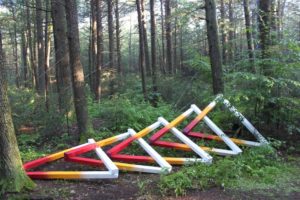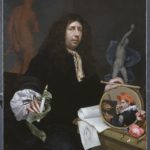Fast Forward Futures
Caption: Fast Forward Futures (2017). Installation at Harvard Forest. 4 × 8 × 26 feet; wood, acrylic paint, and assorted hardware. Collaborators: David Buckley Borden, Jack Byers, Aaron M. Ellison, Salvador Jiménez-Flores, and Salua Rivero. Photograph: David Buckley Borden.
Fast Forward Futures (2017) is featured in “Hemlock Hospice: landscape ecology, art, and design as science communication” by Aaron M. Ellison and David Buckley Borden in the new Routledge Handbook of Art, Science and Technology Studies (2021). Situated adjacent to and pointing toward a gap created by a dead and fallen eastern hemlock and now succeeding to a new forest of black birch, Fast Forward Futures is an abstraction of the “fast forward” icon of a media player. It is created from five interlocking delta symbols representing change and painted in a global-warming-inspired heat gradient.
The Routledge Handbook of Art, Science, and Technology Studies defines the modes, practices, crucial literature, and research interests of this emerging field. It explores the questions, methodologies, and theoretical implications of scholarship and practice that arise at the intersection of art and STS. More than sixty artists, scientists, STS scholars, and curators contributed to this 42 chapter book, with forewords by STS scholar Trevor Pinch and art historian Caroline A Jones. The book’s chapters engage a range of sensory modes as part of immersive art-science works and exhibitions.
Drawing on methods and concepts derived from STS and allied fields including visual studies, performance studies, design studies, science communication, and aesthetics and the knowledge of practicing artists and curators, ASTS is predicated on the capacity to see both art and science as constructions of human knowledge- making. Accordingly, it posits a new analytical vernacular, enabling new ways of seeing, understanding, and thinking critically about the world. This handbook provides scholars and practitioners already familiar with the themes and tensions of art–science with a means of connecting across disciplines. It proposes organizing principles for thinking about art–science across the sciences, social sciences, humanities, and arts. Encounters with art and science become meaningful in relation to practices and materials manifest as perceptual habits, background knowledge, and cultural norms. As the chapters in this handbook demonstrate, a variety of STS tools can be brought to bear on art–science so that systematic research can be conducted on this unique set of knowledge-making practices.


